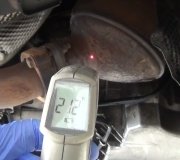You're describing exactly the way my '88 Grand Caravan acted. It was one of the hottest days in summer. I drove over three hours, through Minneapolis, then there was a slight sputter when leaving a stop light; just enough to get my attention. 30 miles later the engine died when I let off the accelerator pedal to turn off the highway. It cranked but wouldn't restart until five minutes later. After I visited the shop I went to see, it took me four hours to nurse it back through Minneapolis, then it ran fine at highway speed for another three hours until I started to coast, then it died again.
Next day it was just as hot, and the engine died repeatedly around town, then it was fine for the next six months. Funny thing is, outside temperature should not have played a role with this problem. The solution was a new strainer in the gas tank. $12.00 and didn't have that problem until about 12 years later, then only when dragging a huge tandem axle enclosed trailer that's bigger than the van. While driving with the fuel pressure gauge attached, I could see the fuel pressure gradually drop off from the normal 50 psi to less than 20 psi. It wasn't until it hit 15 psi that the engine would start to sputter.
A clue that I learned by doing that was the fuel pressure would instantly pop back up to normal if I lifted the accelerator pedal for a fraction of a second. Once I pressed it again to keep my speed up, it took from about ten to 20 seconds for the pressure to drop off again. I nursed it home over 50 miles that way. Coincidentally, that happened multiple times over a few days that were very hot in the middle of summer.
This article shows testing the fuel pump:
https://www.2carpros.com/articles/how-to-check-fuel-system-pressure-and-regulator
but that is not what we're after. It's important to understand that when Chrysler fuel pumps fail, they almost always fail to start up, leaving you sitting in the driveway or parking lot. Once they start up, they rarely quit while you're driving. (GM fuel pumps are just the opposite. They almost always start up, then they quit or slow down while you're driving, leaving you sitting on the side of the road). On Chrysler products, with running problems that develop while you're driving, the fuel pump is way down at the bottom of the list of suspects, but that strainer is up at the top of the list. From your description of the symptoms, the strainer is a far better suspect than any sensor, but we want to verify that first by watching what the fuel pressure does when the problem occurs. This article shows how to connect the gauge. The first time I drove my minivan with the gauge attached, I had it stuck under the right wiper arm. The second time I drove it for a year and a half with the gauge strapped to the radio antenna.
If fuel pressure proves to not be the cause of this problem, we will need a scanner to see what the Engine Computer is seeing and reacting to when the problem occurs. The last thing I want you to do is to replace a lot of random parts. That is the least effective way to solve a problem, and it is often more expensive than getting a professional diagnosis.
You should also read and record the diagnostic fault codes. Chrysler made doing that yourself much easier than any other manufacturer. Cycle the ignition switch from "off" to "run" three times within five seconds without cranking the engine, leave it in "run", then watch the code numbers appear in the odometer display. You can go here:
https://www.2carpros.com/trouble_codes/obd2/p0300
to see the definitions, or I can interpret them for you. Be aware, there are no fault codes for low fuel pressure. There are, however, multiple possible codes for things that resulted from low fuel pressure.
Saturday, February 1st, 2020 AT 5:55 PM



